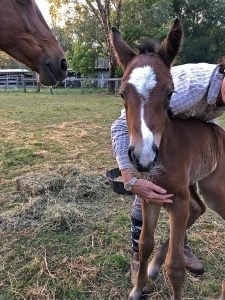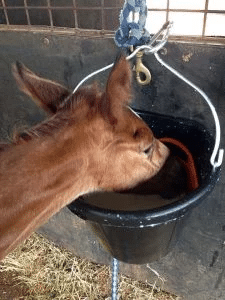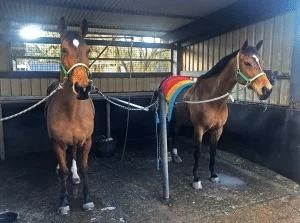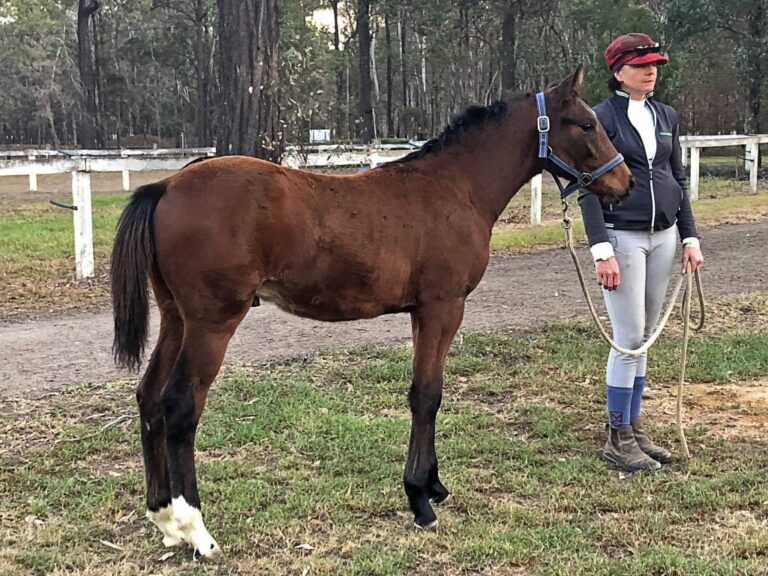So you’re thinking of breeding from your mare? A wonderful idea, but once that much anticipated foal arrives, what then? Amanda Mac asked renowned warmblood breeder Helen Chugg for some expert advice on the finer points of foal handling.
Who better to offer advice on handling a foal than Helen Chugg, one of our foremost and most successful breeders of warmbloods? Responsible for bringing some of the best bloodlines in the world to Australia, Helen’s renowned Diamond B Farm, located north-west of Sydney at Freemans Reach, has a reputation for consistently producing top quality foals. “We breed both for ourselves and commercially, and we also manage foaling for other owners,” Helen explains.
A no-nonsense approach
Allow time for bonding before you attempt to handle your foal.

When talking to Helen, it quickly becomes clear that she favours a relaxed, no-nonsense approach to handling foals. Now, if you’re at all interested in foals and their well-being, you’ve probably noticed on-line discussion around imprinting, the theory that handling a foal immediately after birth is likely to impact positively on its future training. Informed by many years’ experience, Helen has some interesting views on this subject.
“I never interfere with the birth process unless I have to, nor do I get between a mare and her foal for those first all-important hours,” she says.
Helen believes that the mare’s reaction to her foal must also be considered. Some mares have little objection to their foals being handled, others become upset, a situation that should be avoided.
“You don’t want to distress the mare, or interfere with the bonding process. So I generally allow at least 12 hours after birth before I attempt to start cuddling, touching, and scratching the foal,” she adds.
Be aware of your foal’s personality
Helen emphasises the importance of assessing the foal’s personality and the way in which they react to you: are they friendly and keen to approach? Or, do they tend to be timid and hang back.
“Bolder foals can become overfamiliar and therefore too pushy. They want to be in your face all the time! You need to set boundaries with them by not letting them push you or get too close. Their instinct is to play, and some will come at you as if you are another foal. This is when you need to adopt essentially the same tactics that their mother would use, by being firm and pushing them away. Obviously the object is not to frighten them, but it’s really important to set boundaries,” Helen says.
Feeding an orphaned foal

Diamond B’s hand raised bub drinking from her milk bucket.
In the worst possible case scenario, a mare might die while birthing, or may reject her foal completely – so how do you deal with what is, one way or the other, an orphaned foal?
“One of our mares totally rejected her foal so we decided that rather than finding a foster mum, which is one possibility, we would hand-raise her. If you’re in this situation, don’t make the mistake of making the foal a pet. Handle them like a normal horse – feed them but don’t play. Familiarity can breed contempt, and the foal needs to learn to treat you as a person rather than another horse. We used the best quality milk replacement we could find on the market, and later fed her good quality hay. We also feed our foals Prydes BioMare if they need a little extra condition, or KER All Round Phase Pellets, depending on need and when they are ready to eat. But I would recommend that you ask advice from experts you admire in industry, and be careful to avoid over feeding,” she adds.
The problem of the fussy feeder
Some foals can be fussy feeders, and this in itself is a real problem – but not at the Diamond B Farm. “We breed warmbloods and we’ve never had a fussy foal yet,” laughs Helen. “But again, getting expert advice is critical. If a foal is stressed and off their feed, the integrity of their stomach lining could be compromised – so it’s important to act quickly and seek your vet’s input,” she advises.
Training your foal

A butt rope will help encourage foals that are unwilling to lead.
So when should you start familiarising your foal with the head collar, and everyday procedures such as grooming, or picking up their feet? As it turns out, that again depends upon your foal’s temperament.
“We work to the foal’s personality,” says Helen. “If they’re timid or scared, we don’t make it a big issue as we don’t want them to become fearful. You also need to be very conscious when head collaring and teaching the foal to lead that you don’t negatively affect their neck. We teach through a pressure and release technique, first ensuring that they’re in a safe environment. Depending on the foal, some will automatically follow you. For those that are not good at coming forward after release, we use a butt rope to encourage them without putting pressure on their neck,” she adds.
Foals are quite strong and can move with surprising speed. This can make for a potentially dangerous situation, so their safety (and yours) must be a priority – particularly when dealing with a timid foal that’s likely to be easily frightened.

Diamond B’s bucket raised foal at age four, standing next to her mother who now quite likes her!
Helen has a strategy for this: “In this instance we introduce the foal and mare to a double crush system, so that the foal learns to be handled in a safely confined space while having the comfort of their mother alongside them. Additionally, after weaning all our foals spend two to three weeks in the main stables. We walk them every day, sometimes putting them on the walker with other foals. And if they haven’t already learned to come to a bucket of feed, this is the time when we’ll teach them,” she explains.
“Also, bear in mind that when you’re dealing with a foal it’s important to avoid long training sessions, keeping them short and frequent is always preferable. But that said, by the time they’re yearlings, you should have them leading well.”
Safety first
Helen is adamant that safety should always be foremost in your mind. She recommends building a good relationship with your foal, and if they’re timid, handle them in a calm manner in a controlled environment to avoid injury to the foal or yourself.
“I’ve seen photos online of people lying or sitting down with their foals. This is definitely not something I would recommend. And if you have a foal that is either timid or aggressive, don’t ever be frightened to ask for expert help. It’s important to get the situation under control before it has a chance to become worse.”
And a final word of advice from Helen: “We tend to let our foals be foals, without the intervention of constant touching. I don’t rug foals, and I don’t overdo contact. They need a herd situation and a spacious environment in which to grow up. Social interaction is vitally important to their well-being – so give them the room to make their own friends.”
All foals bred at Diamond B spend two to three weeks in the main stables.
Follow these links for more on Helen Chugg and the Diamond B Farm.



